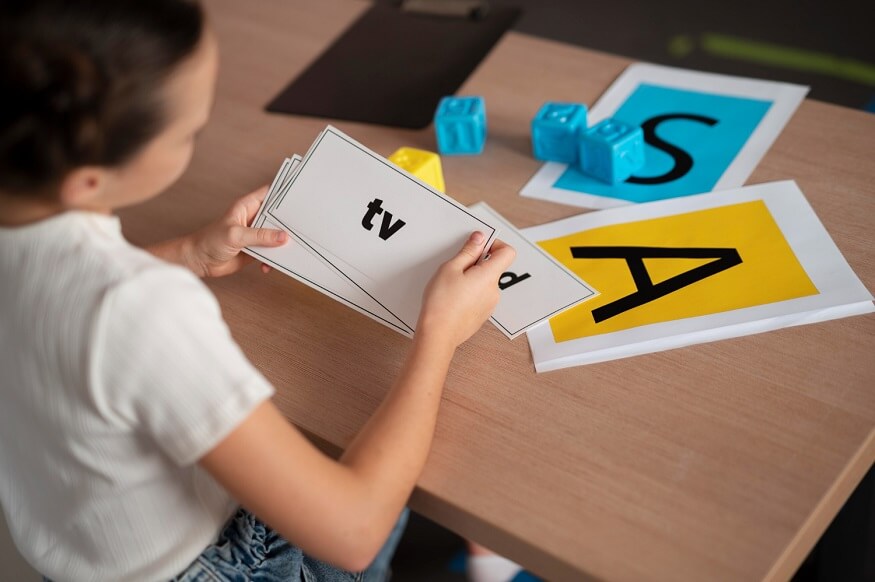Understanding phonemes and phonics is super important if you want to learn how to read or help someone learn to read in English. They are like the building blocks for getting really good at reading and writing. In this article, we’ll talk about these ideas a lot and give you all the details you need if you’re a teacher, parent, or student.
Also read: How Can You Introduce Phonics To 1-2-Year-Olds
What Is Phonics?
Phonics is a way to learn reading by looking at how letters and their sounds work together. It helps people figure out what sounds letters and groups of letters make when we talk. This makes it easier to sound out words and read better.
Key Points About Phonics:
- Phonics for Kids: Phonics helps kids match sounds with letters. This makes reading easier and more fun!
- Phonics Sounds for Kids: By learning different sounds, kids get better at reading smoothly and understanding what they read.
- Teaching Phonics: This means showing kids how letters and sounds go together and how to blend them to make words.
Phonics lays the groundwork for reading proficiency, making it a crucial component in early education.
Also read: Early Literacy Skills in Kindergarten: Letters and Sounds
What Is a Phoneme?
A phoneme is like a tiny sound you hear in words that makes them different from each other. In English, phonemes are just small sounds that you put together to make words.
Understanding Phonemes
– Phoneme Examples: Phonemes are like the sounds that make words different. For example, the sound /b/ in “bat” and the sound /p/ in “pat” are different phonemes. They help make words sound unique!
– How to Pronounce Phoneme: It’s important to say phonemes correctly so people can understand us clearly and learn to read better. When you say the sounds right, it helps everyone know what you mean.
– Phonemic Awareness: This means being able to hear, recognize, and play with different phonemes. It’s super important because it helps us learn how to read and spell words correctly.
Recognizing and manipulating phonemes is essential for mastering reading and spelling in English.
Difference Between Phonics and Phonemic Awareness
Phonics and phonemic awareness are like friends, but they do different things. Phonemic awareness is when you can hear and play with the sounds in words, like finding out how many sounds are in “cat.” Phonics is when you learn how these sounds match with letters, like knowing that the letter “c” makes the “kuh” sound in “cat.” So, phonemic awareness is about hearing the sounds, and phonics is about linking those sounds to letters.
Key Differences:
- Phonemic Awareness: This is all about listening. You don’t need to know how to read or write for this.
- Phonics: This one is about both listening and looking at letters. It helps you figure out how to read and spell words.
Knowing these differences helps teachers pick the best ways to help kids learn to read and write.
Importance of Phonemic Awareness
Phonemic awareness is really important for learning to read. It means being able to hear and play with the smallest sounds in words, called phonemes. These sounds help us figure out what words are and what they mean.
Also read: First Grader Goals for Early Reading and Writing
Benefits of Phonemic Awareness
– Helps with Reading Early: When you know about phonemic awareness, it makes learning to read and write easier.
– Better Spelling: Knowing phonemes helps you spell words because you understand how sounds match up with letters.
– Starts Phonics Learning: Phonemic awareness is like a first step for learning phonics, so it’s simpler to figure out how letters and sounds go together.
Fostering phonemic awareness in young learners enhances their reading and writing skills.
Teaching Phonics Effectively
Learning phonics is like putting together a puzzle with letters and sounds. To help kids understand how letters make sounds and words, we use some fun and organized methods. By following these steps, students can figure out words and get better at reading!
Key Strategies:
- Show and Tell: Clearly teach how letters and sounds go together, step by step.
- Word Fun: Practice blending and breaking down words to get better at phonics.
- Playtime Learning: Use games and fun activities to practice phonics sounds.
Incorporating these strategies helps build a solid foundation in phonics, leading to improved reading skills.
Phoneme Examples in English
Knowing what phonemes are helps us understand how different sounds come together to make words. By looking at different phoneme examples, we can see how many sounds there are in English.
Examples of Phonemes:
– Consonant Phonemes: /k/ in “cat,” /s/ in “sun.”
– Vowel Phonemes: /i/ in “sit,” /a/ in “cat.”
– Blends and Digraphs: /sh/ in “ship,” /th/ in “this.”
Learning and practicing these phoneme examples enhances phonetic understanding and reading ability.
Also read: Signs And Symptoms Of Childhood Lisping
The Role of Phonics in Reading Development
Phonics is really important for learning to read. It helps us figure out how to sound out words. It’s a big part of learning to read when we’re little and helps us go from just reading words to understanding what we’re reading.
If you want more help with reading, you might want to check out EuroSchool. They have cool programs and people who can make learning fun and help you get better at reading!









